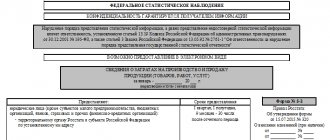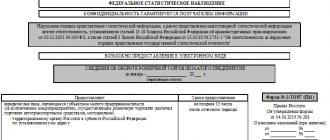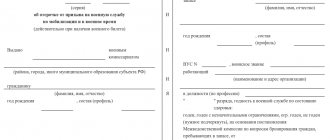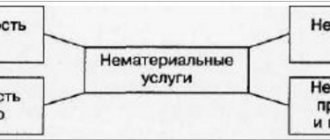One of the types of statistical reporting that business entities provide to statistical authorities is information on the volume of paid services provided to the population. The purpose of the report is to monitor the results of respondents’ activities in this area. We have widely covered the changes that Rosstat introduced en masse to reporting forms in 2021. In this review, we will talk about the changes that statistical form No. 1-services has undergone, by whom and when the report is submitted, and we will reveal the details of filling out the report. At the end of the review, you will be able to study the sample filling and download the new report form for Form No. 1-services for 2021.
Who submits Form 1-Services
Form 1-Services is used to report to everyone who provides paid services to the population. This applies to organizations, individual entrepreneurs and legal entities (with the exception of law offices).
Until 2021, form No. 1-IP (services) was provided for individual entrepreneurs, but now it has been canceled. For 2021, entrepreneurs will submit Form 1-Services, just like a legal entity.
Individual entrepreneurs who are engaged in the fields of agriculture, insurance, retail trade or public catering do not need to report on the form.
As for small businesses, not all of them will have to submit a report for 2021. In accordance with Art. 5 No. 209-FZ, statistical observation of the NSR is carried out on a selective basis. If your company is included in the sample, you will be sent a letter. But Rosstat does not always do this, so it is better to call the statistics service department in advance or check all mandatory reports on the official Rosstat website. Ignorance of the need to report will not exempt you from fines.
Once every five years, a comprehensive survey of business entities is carried out. The next time it is expected is in 2021, so be ready to report back.
Deadlines and procedure for submitting Form 1-Services
Form 1-Services is submitted annually. In 2021, you need to report for 2019. The deadline for this is no later than March 1. But since the date falls on Sunday, the report can be submitted on Monday, March 2.
If you are a small enterprise, but were not included in the list of those required to report before this deadline, it means that you managed to avoid the survey this year.
The form can be submitted in paper or electronic form. Place of delivery - territorial bodies of Rosstat:
- for organizations - according to legal company address or place of actual business;
- for separate units - at location;
- for individual entrepreneurs - at the place of registration or at the place of actual business, if they do not coincide.
For organizations with separate divisions, several forms are required. It all depends on the area where you are located. If a legal entity and separate divisions are located in the same entity, then they submit one form; if in different ones, a separate form for each division and a separate one for the legal entity.
In what form should the report be submitted?
On paper
Submitting a report on paper is extremely simple:
- Download form 1-yes.
- Complete the title page and sections.
- Take it to the local statistical office.
The completed form can be submitted by the manager or representative of the enterprise, but only after presenting a power of attorney signed by the head of the enterprise.
Electronic
Electronic reporting, which is submitted via telecommunication channels (TCC), is a more convenient method.
Algorithm for submitting an electronic report:
- Download and install the software.
- Fill in the fields of the form.
- Send to recipient.
The electronic form has additional requirements for the design and preparation of the questionnaire:
- You need to submit the completed form only in XML format;
- An incorrectly completed form, non-compliance with the file format, violation of arithmetic and logical calculations are considered false information, for which a fine or resubmission of the report will be imposed.
The stated procedure for receiving and processing statistical information, approved by Rosstat Order No. 370 dated October 27, 2007, contains the following information on processing and reporting:
- Primary reporting submitted after the deadline, even in XML format, is unreliable and is considered not submitted. This entails administrative penalties.
- If the respondent reported electronically, then the statistical authorities do not have the right to require filling out a paper form.
How to fill out form 1-Services
Report form 1-Services is otherwise called OKUD 0609703 and approved in Appendix No. 4 to Rosstat Order No. 418 dated July 22, 2019. For the report for 2021, several innovations have appeared, so the procedure for filling out the form has also changed.
Form 1-Services is small, it includes a title page and two sections. In them, organizations and entrepreneurs must talk about the types and volumes of paid services for the population and make a breakdown by territory (for legal entities).
Before proceeding to filling it out, it is worth considering several nuances that determine the need to enter information into the form. Information in the report should include service providers who accepted the order from the consumer themselves and directly received payment from him. Therefore, you do not need to take into account revenue if:
— The service provider received payment from his client’s employer. For example, an organization bought an employee a trip to a sanatorium: the cost of the trip in the report is reflected by the employer, not the sanatorium.
— The service provider engaged a third party to place an order or receive payment from the consumer. For example, a transport company sells tickets through an agency. The data in the report is included not by the transport company, but by the agency. In this case, the intermediary fee is taken into account.
Let's take a closer look at the process of filling out the form.
Title page
On the title page you must disclose all the basic information about yourself. The data for organizations and entrepreneurs is slightly different.
In the address part of the company indicate its full name, as indicated in the constituent documents, and its abbreviated name. For separate divisions, indicate its name and the name of the legal entity to which it belongs. Individual entrepreneurs indicate only their full name.
In the “Postal Address” line, the legal entity indicates the legal address and the actual address, if they do not match. Separate divisions without a legal address provide a postal address and zip code. The individual entrepreneur indicates the postal address at the place of registration.
Section 1
In the first section, the respondent must talk about the volume of services provided to citizens on a reimbursable basis during the year. The scope of services is indicated:
- in prices valid at the time of payment;
- in thousands of rubles;
- including VAT and other payments;
- taking into account the cost of materials necessary to provide the service;
- with one decimal place.
Receipts are distributed by type of service line by line.
Line 01 is the result. It contains the total volume of services that the respondent provided to the population during the year on a reimbursable basis. Consumers of services can be citizens of the Russian Federation and other countries.
The volume of services from line 01 is distributed across lines 02 - 31 by type of service based on OKPD2.
In lines 02 - 14, indicate household services to the population. From the nuances:
- on line 04 it is necessary to indicate the cost of certificates for additional maintenance of equipment and equipment that the population purchases to extend warranty service;
- line 05 indicates repair services for vehicles and motorcycles, which are provided at the expense of insurance companies.
In lines 15 - 17, indicate transportation and communications services: transportation, mail, couriers, telecommunications services.
Line 18 indicates housing services. A limitation has been introduced as of the 2021 report. Thus, this line does not need to reflect contributions for major repairs (for owners of premises in apartment buildings) and the amount of utility resources for the maintenance and use of common property.
In line 19, the volume of services is provided by organizations and local authorities that supply residents with resources: electricity, heat, water. This includes utility payments from the population, as well as the supply of fuel and household gas to citizens.
In line 21, travel agencies show the full cost of the tourism product sold directly to the public. It could be formed by both a resident and a non-resident of the Russian Federation. Payments to foreign service providers do not need to be included here.
Lines 22 and 25 are very similar in content - both involve population placement. But line 22 is for hotels, hotels, hostels, etc. that clean their rooms every day. Line 25 - for campsites, camps, recreation centers, resorts, etc.
Line 28 is relevant for legal entities. It reflects remuneration for legal assistance to citizens and compensation for expenses. Other organizations providing similar services enter data in line 31.
Line 31 indicates all other paid services that were not included in the previous lines.
Section 2
The second section was introduced for the 2021 report. It is intended for organizations (except small businesses) only. In it, companies distribute paid services to urban districts and municipal areas. The section is completed for each separate division.
The new section is quite simple. The first column indicates the name of the entity where the service was provided. In the second column is the OKTMO code. The third column shows the volume of paid services for this education.
When filling out, do not forget about the control ratio: the sum of the lines in column 2 must be equal to the number in line 01 in column 4 of section 1.
Form 1-Services Sample form 1-Services
Taxes and business activities
EXPLANATIONS for filling out the state statistical observation form No. 1-
General provisions
1. These Explanations contain information about the indicators of the state statistical observation form No. 1- (hereinafter referred to as the form).
2. The form is provided by enterprises - legal entities, separate divisions of legal entities (hereinafter - enterprises), which are identified by the main type of economic activity as service enterprises, and in accordance with the Classification of types of economic activities of the Civil Code 009:2010 (hereinafter - KVED) carry out activities in the field of: – transport, warehousing, postal and courier activities (section H); – temporary accommodation and catering (section I); – information and telecommunications (section J); – transactions with real estate (section L); – professional, scientific and technical activities (section M); – administrative and support services (section N); – education (section P); – health protection and provision of social assistance (section Q); – arts, sports, entertainment and recreation (section R); – provision of other types of services (sections 95 and 96 of section S).
3. According to the Classification of Economic Activity, services are the result of economic activity, in respect of which ownership rights cannot be established. Services cannot be sold separately from the process of their production. The moment the production of a service is completed coincides with the moment it is provided to the consumer.
4. Services are understood as economic activities carried out, as a rule, on order in accordance with the demand of the consumer (individual citizens, enterprises, organizations, entrepreneurs) with the aim of changing the state of consuming units (either the physical or intellectual state of the consumer himself, or items belonging to him) .
5. The form displays the results of the actual activities of the enterprise in the sale of all types of services (main and secondary activities). The form does not contain data on the activities of the enterprise in the production and sale of goods (industry, agriculture, construction, production of electricity, gas, water, heat supply), as well as in the provision of financial services.
6. Enterprises that are primarily financed from budgetary funds show in the report only sales of the main type of economic activity at market prices (if such services were sold during the year).
7. The form contains data for the reporting year. When drawing up an annual report using the form, clarifications are made to the data for all months of the reporting year that were not taken into account in the monthly reports of the enterprise.
8. These forms correspond to the data of the primary documents, in accordance with which services are performed and accounted for (receipts, checks, tickets for travel on public transport, work orders, commitment orders, certificates of work performed, etc.).
9. All cost indicators are given in thousand Russian rubles. with one decimal place.
Indicators and content of the form
Section I. Sales of services
1.1. Line 02 “Volume of services sold” provides data on the volume of services sold, performed by the enterprise’s own resources. It is determined by the sales price of finished products (services performed) shipped outside the enterprise, which is indicated in the documents drawn up as the basis for settlements with buyers (customers) (including services (products) under a barter contract). Services are considered implemented after paperwork is completed, regardless of receipt of payments.
1.2. The volume of services sold also includes: – the cost of transport, packaging and other work performed by the enterprise’s own resources, which are compensated at the expense of the buyer; – cost of services for operational lease of assets.
1.3. An enterprise that engages third-party enterprises (contractors, subcontractors) to perform services on a contractual basis, includes in the total volume of sales the cost of the services of the contractor (subcontractor), if they are provided on the basis of providing raw materials to be supplied.
1.4. Enterprises containing housing, communal services and socio-cultural facilities on their balance sheets reflect the cost of services sold outside the enterprise or to their employees (members of their families) on a commercial basis in the volume of services sold (products, works). The volumes of products (services) sold by these divisions are taken into account in the total volume of sales as secondary types of economic activity.
1.5. Discounts provided to customers are not excluded from the volume of services (products, work) sold. The volume of services sold does not include: – the cost of products of own production for the internal needs of the enterprise; – the amount of subsidies and subsidies received for production; – amounts of advance payment for services (products, works); – advance payments; – receipts that belong to third parties (other enterprises), i.e., if the enterprise performed intermediary functions, only the margin for intermediation is displayed in the volume of services sold. 1.6. The volume of services sold (products, work) for certain types of economic activity is determined as follows: – transport – as the cost of services sold outside the enterprise for all types of transportation; – pipeline transport – as the cost of services sold outside the enterprise for the transportation of oil, petroleum products, gas and other products without the cost of the products themselves; – warehousing – as the cost of services sold outside the enterprise for storage and warehousing of all types of goods, hydrocarbons, liquid or gaseous fuels, chemical products, etc. in the relevant warehouses (in general-purpose commodity warehouses, granaries, refrigerated warehouses, bunkers, etc.) without taking into account the cost of the goods accepted for storage; - auxiliary activities in the field of transport - as the cost of services for auxiliary maintenance of transport, for the transport processing of goods (loading and unloading); – postal and courier activities – in terms of the activities of the national postal operator – as the cost of services provided for the reception, processing, transportation and delivery (delivery) of postal items and other postal services; in terms of other postal and courier activities - as the cost of services provided for the collection, transportation and delivery of letters, parcels and parcels carried out by other business entities (except for the national postal operator); – temporary accommodation and catering – in relation to the activities of hotels and similar places of temporary accommodation – as the cost of the services provided; in terms of the activities of restaurants (restaurant enterprises) - as the cost of services for serving food and drinks, including the amount of the trade margin and the cost of products; – publishing activity – as the cost of searching for authors to acquire copyrights to the content (information products - books, brochures, booklets, dictionaries, encyclopedias, atlases, maps and diagrams; newspapers, magazines and periodicals, catalogs and other types of printed publications) and its publication (publication) by reproduction and distribution in various forms: in printed, electronic or audio form, on the Internet, in the form of multimedia products, etc.; – scientific research and development – as the cost of research and experimental developments carried out on one’s own in the field of natural and technical, social and human sciences; – the activities of travel agencies and tourism operators – in terms of the activities of travel agencies – as the amount of commission for the sale of a tourism product of tourism operators and tourism services of other subjects of tourism activity or the difference between the sale and purchase price of a tourism product; in terms of the activities of tourism operators - as the cost of created and sold tourism products, as well as provided tourism services; - comprehensive maintenance of facilities (activities of housing maintenance enterprises) - as amounts accrued to tenants for payment for services provided for the maintenance of houses and local areas, except for subsidies provided to certain categories of citizens, and compensation for losses of enterprises associated with the establishment of prices/tariffs for services below the economically justified costs of their production; – information and telecommunications – as the cost of services provided for radio and television broadcasting, telecommunications (telecommunications) (including maintenance of technical means and communication facilities of all types), computer programming, and other information services; – real estate transactions, professional, scientific and technical activities, activities in the field of administrative and support services, education, healthcare and social assistance, art, sports, entertainment and recreation – as the cost of services sold outside the enterprise.
1.7. On lines 03–05, the volume of services sold is distributed by categories of consumers: population, enterprises (organizations) and other consumers (for example, individual entrepreneurs). The distribution of the volume of sales of services for different categories of consumers is given on the basis of documents for payment for services (the sum of the data in lines 03–05 is equal to the data in line 02).
1.8. Line 08 “Material costs” indicates the costs associated with the provision of services: – the cost of raw materials and basic materials used in production, semi-finished products and components, fuel and energy, building materials, spare parts, containers and packaging materials, auxiliary and other materials (stationery, products for medical and preventive nutrition of workers, etc.); – testing of raw materials and materials used in production; transport services, which are a component of the technological production process, etc.; – costs associated with the use of natural raw materials (payment for water that is taken from water management systems within approved limits, as well as payments for the use of other natural resources, for emissions and discharges of pollutants into the environment, waste disposal and other types of harmful effects within the limit).
1.9. Line 09 “Other operating costs” indicates the costs of operating activities associated with the provision of services, in particular the costs of business trips within established standards, the cost of work, services of third-party companies (communications, transport, education, healthcare, routine maintenance and repairs) vehicles, office and computer equipment, etc.), fees for settlement and cash services, the amount of taxes, fees, mandatory payments (except for indirect taxes, income tax), depreciation of inventories, damage to valuables, write-off and depreciation of assets, amounts of financial sanctions (fines, penalties, penalties), rent, expenses of the enterprise for the payment of scholarships to students studying at educational institutions in the direction of the enterprise, etc. Labor costs, deductions for social events, and depreciation on line 09 are not displayed. 1.10. Line 10 “In addition, income from the rental of industrial non-residential premises” indicates the amount of accrued funds (excluding the amount of utility bills) for the rental of premises used for industrial purposes. The data in line 10 is not included in the data in line 02 “Volume of services sold” and is not displayed in section II “Information on the types of services sold.” Enterprises for which the provision of lease and operation of their own or leased real estate (NACE code - 68.20) is the main type of economic activity, line 10 is not filled in, since the cost of services for this type of activity is taken into account on line 02.
Section II. Information about the types of services provided
2.1. The section contains information about all types of services provided by the enterprise. The number of completed lines in the section corresponds to the number of types of services provided by the enterprise in the reporting year.
2.2. Column A displays the types of services, and column B displays the corresponding codes for the types of services. The type and code of the service is indicated in accordance with the Statistical Classification of Products, approved by Order of the State Statistics Committee of Ukraine on December 23, 2011 No. 397. The list of types of services is attached to the form. The first is the type of service that occupies the largest share in the total volume of services sold by the enterprise.
2.3. Column 1 displays the volume of services sold to all categories of consumers, column 2 shows the volume of services sold to the population (individual citizens).
2.4. The line “Total for the enterprise” reflects the total volume of services sold. The data in the line “Total for the enterprise” in column 1 is equal to the data in line 02 of section I. The data in the line “Total for the enterprise” in column 2 is equal to the data in line 03 of section I.
2.5. The amount of data by type of service is equal to the data in the “Total for the enterprise” line.
Zero form 1-Services
The Statistics Service provided for the submission of a report on services even if activities were not carried out or suspended during the year.
If an organization or individual entrepreneur has not worked all year, then they submit a report in the general manner, but enter zeros in the lines.
Organizations that have been operating for only part of the year submit the form on a general basis and indicate since when they have not been operating.
If an organization or individual entrepreneur did not provide services to the population in 2019, then instead of a form, you need to send an official letter to Rosstat about the absence of the event under study.







